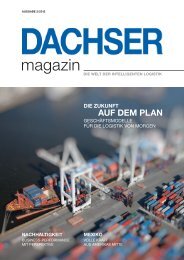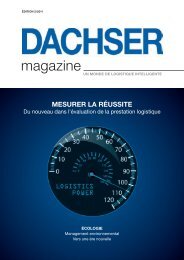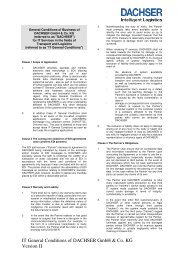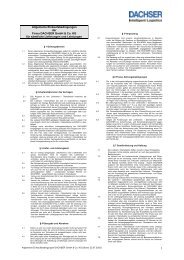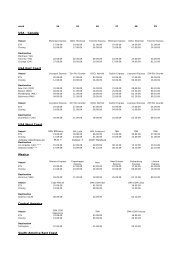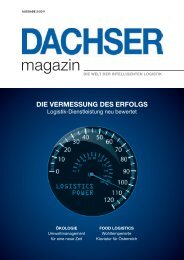magazine - dachser.sk
magazine - dachser.sk
magazine - dachser.sk
Create successful ePaper yourself
Turn your PDF publications into a flip-book with our unique Google optimized e-Paper software.
FORUM: DACHSER FACE-TO-FACE<br />
Bernhard Simon meets ...<br />
Gerd Hailfinger<br />
Radical restructuring: Gerd Hailfinger, managing director of Geberit<br />
Logistik GmbH, winner of the German Award for Supply Chain<br />
Management 2011, talks to the head of Dachser’s management board<br />
about how logistics is becoming a core function within companies.<br />
hh Mr Hailfinger, since 2006 you have<br />
redesigned logistics at Geberit, even<br />
spinning it off as an independent private<br />
limited company (GmbH) last year. What<br />
was the motivation behind this change?<br />
Gerd Hailfinger: Growing markets and<br />
more individual customer requirements<br />
prompted us to review how we could leverage<br />
logistics to control value creation within<br />
Geberit and along the supply chain, and at<br />
the same time enhance customer benefit.<br />
These considerations led us to a new process<br />
model for logistics at Geberit. The objective<br />
was to transfer logistics to an effective,<br />
centralized and independent organization in<br />
order as far as possible to satisfy increasing<br />
customer requirements.<br />
Bernhard Simon: In the previous constellation<br />
it was presumably difficult to coordinate<br />
anything centrally.<br />
G. Hailfinger: The former process model<br />
for supply chain management at Geberit<br />
foresaw no centralized logistics function. Logistics<br />
was an appendage of the individual<br />
production plants. The sales companies organized<br />
transport services to their respective<br />
markets themselves. As a result, a single customer<br />
order would generate several deliveries<br />
at different times and with different degrees<br />
of delivery service. What’s more, this led to<br />
lower truck capacity utilization with accompanying<br />
higher transport costs.<br />
hh Mr Simon, as a logistics provider you<br />
should surely be more in favour of companies<br />
outsourcing issues of this nature<br />
to the experts?<br />
08 DACHSER <strong>magazine</strong><br />
B. Simon: Not necessarily. If we are looking<br />
at superficial structures or short-term<br />
economies of scale, there is little to gain from<br />
outsourcing. To us, it’s important to be able<br />
to offer the customer concrete added value.<br />
Only if we can identify this is there any point<br />
in us sitting down with the customer and discussing<br />
the issue. For example if ta<strong>sk</strong>s grow so<br />
complex that sufficient production or warehousing<br />
space is no longer available or production<br />
processes have to be reorganized –<br />
that’s when the logic of contract logistics<br />
starts to make sense.<br />
We optimize<br />
hh processes, which<br />
automatically results in<br />
cost savings but without<br />
jeopardizing quality Gerd Hailfinger<br />
G. Hailfinger: To begin with we a<strong>sk</strong>ed<br />
ourselves: Where does logistics actually kick<br />
in? In our present model, we take logistics<br />
considerations into account as early as the<br />
product development stage and extend this<br />
via purchasing, production, distribution,<br />
transport management, through to our customers.<br />
The objective of the new SCM<br />
process model was to have integrated group<br />
logistics take on an essential and clearly<br />
defined role in each process element of the<br />
supply chain.<br />
hh To what extent have changes in the<br />
production landscape made such a complex<br />
re-evaluation of logistics necessary?<br />
B. Simon: Production and sales patterns are<br />
changing much faster and more dynamically<br />
than in the past. When it comes to global<br />
sourcing, Germany in particular has in recent<br />
years repeatedly identified the best sources<br />
for buying top quality at low cost and improving,<br />
refining and selling existing products<br />
on the world’s markets. This is only possible<br />
with logistics solutions capable of responding<br />
flexibly to these dynamic processes.<br />
Logistics, and contract logistics in<br />
particular, has thus become a decisive strategic<br />
focus that needs to be addressed in consultation<br />
with the customer’s management.<br />
hh The more involved you become in<br />
the processes, the more responsibility<br />
you assume for ensuring they are successfully<br />
implemented. Is this in your interests?<br />
B. Simon: In contract logistics we are happy<br />
to assume this additional responsibility.<br />
The teams merge into one, resulting in<br />
shared decisions carried by two companies<br />
that organize the entire supply chain and are<br />
therefore sitting in the same boat. By pooling<br />
strengths in seamless supply chains it’s possible<br />
to achieve far more than in a conventional<br />
interaction model bound by classical<br />
contractual limits.<br />
hh Establishing logistics as a core competence<br />
meant centralizing and reorgan



